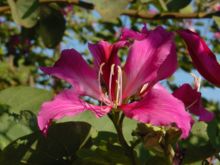Bauhinien
| Bauhinien | ||||||||||||
|---|---|---|---|---|---|---|---|---|---|---|---|---|
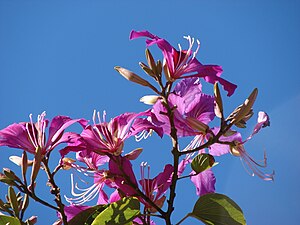
|
||||||||||||
| Systematics | ||||||||||||
|
||||||||||||
| Scientific name | ||||||||||||
| Bauhinia | ||||||||||||
| L. |
The Bauhinia ( Bauhinia ), recently often by transfer from the English term "orchid trees" orchid trees called, are a plant genus in the family of legumes (Fabaceae). It is pantropical with about 250 to 300 species . Some species are used as ornamental plants in tropical and subtropical gardens, parks and avenues because of their beautiful, fragrant flowers reminiscent of orchids .
description

Appearance and leaves
The ever-woody Bauhinia species grow as evergreen or deciduous shrubs , trees or lianas . Some species have tendrils. In some species, thorns are present next to the base of the petioles.
The alternate and spiral or two-line arranged leaves are divided into petioles and leaf blades. The leaf blades are bilobed or simple, rarely they are two-part. The main nerve ends in a free, small point and there are three to 15 side nerves of the first order; they are feathery, parallel or fan-shaped. Often the leaf surfaces are hairy, but only simple trichomes are present. The stomata on the underside of the leaf are paracytic; sometimes there are also widely scattered stomata on the upper side of the leaf. The leaf margin is smooth. There may be stipules that can be very differently designed.
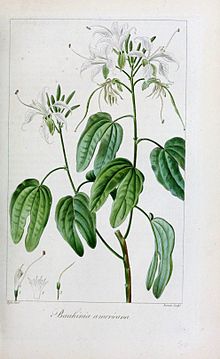
Inflorescences and flowers
Bauhinia species have hermaphroditic and / or unisexual flowers, monoecia , andromonoceia or androdiocee can be present. The flowers are individually in the leaf axils, some are bundled or too many in simple, racemose , paniculate or umbrella- shaped inflorescences . The inflorescences are lateral or terminal; sometimes they are formed directly on the trunk ( cauliflora ). The bracts and bracts are usually small and fail early or are absent, sometimes they are also large and envelop the flower buds.

The mostly large, showy flowers are more or less clearly zygomorphic and usually five-fold with a double flower envelope . The often elongated flower cup (hypanthium) is cup-shaped, bell-shaped or tubular, sometimes it is also very inconspicuous. The five sepals are closed or open in the flower buds with five short or linear calyx tips; they are spatulate or they split into two to five regular to irregular calyx lobes. The five almost identical to strongly different, free petals are hardly to strongly nailed. The color of the petals ranges from white, yellow-orange, pink to purple-red. There are two, three, five or ten fertile stamens , which are often significantly different. The thin stamens are free or only grown together at their base. Staminodes may be present. The single carpel contains one to many ovules . The short to long stylus is usually curved. The differently shaped scars are small to noticeable. There may be a discus.
Fruits and seeds
The flat, elliptical, elongated, obovate or linear, straight or curved legumes have woody or thin fruit flaps; when ripe they open or stay closed and contain few to many seeds. The seeds can endosperm own and the two cotyledons (contained therein cotyledons ) are flat.
Chromosome numbers
The basic chromosome numbers are x = 12, 13 and 14. 2n = 24, or 26, or 28, or 42, or 56 were detected.
Systematics
The first release of the species Bauhinia with the type species Bauhinia aculeata L. was carried out in 1753 by Linnaeus in Species Plantarum , 1, p 374. The generic name Bauhinia honors the acting as botanists brothers Johann Bauhin and Caspar Bauhin , symbolized by the two-piece sheet. The genus Bauhinia belongs to the tribe Cercideae within the Fabaceae family . In the genus Bauhinia s. l. are the species of the former genera Barklya F.Muell. , Bracteolanthus de Wit , Gigasiphon (Drake) Harms , Lasiobema (Korth.) Miq. , Lysiphyllum (Benth.) De Wit , Phanera Lour. , Piliostigma Hochst. , Pauletia Cav. , Amaria Mutis , Casparia Kunth , Perlebia Spix & Mart. , Cansenia Raf. , Monotle Raf. , Telestria Raf. , Ariaria Marq. , Caspariopsis Britton & Rose , Elayuna Raf. , Locellaria Welw. , Schnella Raddi , Lacara Spreng. , Caulotretus Rich. ex Schott , Binaria Raf. , Cardenasia Rusby and Tournaya Schmitz included.

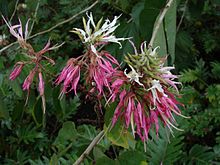
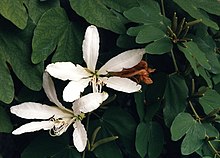







The genus Bauhinia contains about 250 to 300 valid species:
- Bauhinia accrescens Killip & JFMacbr.
- Bauhinia acreana Harms
- Bauhinia aculeata L.
- Mountain Bauhinie ( Bauhinia acuminata L. )
- Bauhinia acuruana Moric.
- Bauhinia aherniana Perkins
- Bauhinia alata Ducke
- Bauhinia altiscandens Ducke
- Bauhinia amambayensis Fortunato
- Bauhinia ampla chip.
- Bauhinia anamesa JFMacbr.
- Bauhinia andersonii K.Larsen & SSLarsen
- Bauhinia andrieuxii Hemsl.
- Bauhinia angulosa bird
- Bauhinia ankarafantsikae Du Puy & R.Rabev.
- Bauhinia apertilobata Merr. & FPMetcalf
- Bauhinia argentinensis Burkart
- Bauhinia aromatica Ducke
- Bauhinia augustii Harms
- Bauhinia aurantiaca Bojer
- Bauhinia aurea H.Lev.
- Bauhinia aureifolia K.Larsen & SSLarsen
- Bauhinia aureopunctata Ducke
- Bauhinia baina JFMacbr.
- Bauhinia bassacensis Gagnep.
- Bauhinia bauhinioides (Mart.) JFMacbr.
- Bauhinia beguinotii Cufod.
- Bauhinia bidentata Jack
- Bauhinia binata Blanco
- Bauhinia blakeana Dunn
- Bauhinia bohniana L.Chen
- Bauhinia bombaciflora Ducke
- Bauhinia bowkeri Harv.
- Bauhinia brachycalyx Ducke
- Bauhinia brachycarpa Benth.
- Bauhinia bracteata (Benth.) Baker
- Bauhinia brevicalyx Du Puy & R. Rabev.
- Bauhinia brevipedicellata Jarvie
- Bauhinia brevipes bird
- Bauhinia burbidgei Stapf
- Bauhinia buscalionii Mattei
- Bauhinia calliandroides Rusby
- Bauhinia caloneura Malme
- Bauhinia calycina Gagnep.
- Bauhinia campanulata SSLarsen
- Bauhinia campestris Malme
- Bauhinia candelabriformis Cowan
- Bauhinia capuronii Du Puy & R. Rabev.
- Bauhinia carcinophylla Merr.
- Bauhinia cardinalis Gagnep.
- Bauhinia carronii F. Muell.
- Bauhinia carvalhoi Vaz
- Bauhinia catingae Harms
- Bauhinia chalcophylla L.Chen
- Bauhinia chalkos Cowan
- Bauhinia championii (Benth.) Benth.
- Bauhinia chapulhuacania Wunderlin
- Bauhinia cheilantha (Bong.) Steud.
- Bauhinia cinnamomea DC.
- Bauhinia claviflora L.Chen
- Bauhinia clemensiorum Merr.
- Bauhinia coccinea (Lour.) DC.
- Bauhinia comosa Craib
- Bauhinia concreta Craib
- Bauhinia confertiflora Benth.
- Bauhinia conwayi Rusby
- Bauhinia cookii Britton & Rose
- Bauhinia corniculata Benth.
- Bauhinia coronata Benth.
- Bauhinia corymbosa Roxb.
- Bauhinia coulteri JFMacbr.
- Bauhinia crudiantha (de Wit) Cusset
- Bauhinia cunninghamii (Benth.) Benth.
- Bauhinia cuprea Ridl.
- Bauhinia cupreonitens Ducke
- Bauhinia cupulata Benth.
- Bauhinia curtisii Prain
- Bauhinia curvula Benth.
- Bauhinia damiaoshanensis T.Chen
- Bauhinia decandra Du Puy & R.Rabev.
- Bauhinia decumbens Henderson
- Bauhinia delavayi Franch.
- Bauhinia dewitii K.Larsen & SSLarsen
- Bauhinia didyma L.Chen
- Bauhinia dioscoreifolia L.Chen
- Bauhinia dipetala Hemsl.
- Bauhinia diphylla Buch.-Ham.
- Bauhinia divaricata L.
- Bauhinia divergens Baker
- Bauhinia dolichocalyx Merr.
- Bauhinia dubia bird
- Bauhinia dumosa Benth.
- Bauhinia eilertsii Pulle
- Bauhinia ellenbeckii Harms
- Bauhinia elmeri Merr.
- Bauhinia endertii K.Larsen & SSLarsen
- Bauhinia erythrantha Ducke
- Bauhinia erythrocalyx Wunderlin
- Bauhinia erythropoda Hayata
- Bauhinia esquirolii Gagnep.
- Bauhinia excelsa (Miq.) Prain
- Bauhinia excurrens Stapf
- Bauhinia exellii Torre & Hillc.
- Bauhinia fabrilis (de Wit) K. & SSLarsen
- Bauhinia ferruginea Roxb.
- Bauhinia finlaysoniana (Benth.) Baker
- Bauhinia flagelliflora Wunderlin
- Bauhinia flava (de Wit) Cusset
- Bauhinia flexuosa Moric.
- Bauhinia foraminifer Gagnep.
- Bauhinia forficata Link
- Bauhinia foveolata Dalzell
- Bauhinia franckii K.Larsen & SSLarsen
- Bauhinia fryxellii Wunderlin
- Bauhinia fulva Korth.
- Bauhinia fusconervis D.Dietr.
- Red Bauhinie ( Bauhinia galpinii NEBr.)
- Bauhinia gardneri Benth.
- Bauhinia gilesii F.Muell. & Bailey
- Bauhinia glabra Jacq.
- Bauhinia glabrifolia (Benth.) Baker
- Bauhinia glabristipes (de Wit) Cusset
- Bauhinia glauca (Benth.) Benth.
- Bauhinia glaziovii deaf.
- Bauhinia godefroyi Gagnep.
- Bauhinia goyazensis Harms
- Bauhinia gracillima (de Wit) Cusset
- Bauhinia grandidieri Baill.
- Bauhinia grandifolia D Dietr.
- Bauhinia grazielae Vaz
- Bauhinia grevei Drake
- Bauhinia guentheri Harms
- Bauhinia guianensis Aubl.
- Bauhinia gypsicola McVaugh
- Bauhinia hagenbeckii Harms
- Bauhinia harmsiana Hosseus
- Bauhinia haughtii Wunderlin
- Bauhinia havilandii Merr.
- Bauhinia hendersonii (de Wit) Cusset
- Bauhinia herrerae (Britton & Rose) Standl. & Steyerm.
- Bauhinia hildebrandtii Vatke
- Bauhinia hirsuta Weinm.
- Bauhinia hirsutiflora Vaz
- Bauhinia hirsutissima Wunderlin
- Bauhinia hookeri F. Muell.
- Bauhinia humilis Rusby
- Bauhinia hymenaeifolia Hemsl.
- Bauhinia hypochrysa T.Chen
- Bauhinia hypoglauca T.Chen
- Bauhinia integerrima Benth.
- Bauhinia integrifolia Roxb.
- Bauhinia involucellata short
- Bauhinia involucrans Gagnep.
- Bauhinia japonica Maxim.
- Bauhinia jenningsii P. Wilson
- Bauhinia jucunda Brandegee
- Bauhinia kalantha Harms
- Bauhinia khasiana Baker
- Bauhinia kingii Prain
- Bauhinia kleiniana Burkart
- Bauhinia kockiana Korth.
- Bauhinia kostermansii K.Larsen & SSLarsen
- Bauhinia kunthiana bird
- Bauhinia kurzii Prain
- Bauhinia lakhonensis Gagnep.
- Bauhinia lambiana Baker f.
- Bauhinia lamprophylla Harms
- Bauhinia leptantha Malme
- Bauhinia leucantha Thulin
- Bauhinia lingua DC.
- Bauhinia lingyuenensis T.Chen
- Bauhinia longicuspis Benth.
- Bauhinia longifolia (Bong.) Steud.
- Bauhinia longipedicellata Ducke
- Bauhinia longiseta Ducke
- Bauhinia longistipes T.Chen
- Bauhinia lorantha Gagnep.
- Bauhinia lucida (Miq.) Prain
- Bauhinia lyrata Raizada
- Bauhinia macranthera Hemsl.
- Bauhinia madagascariensis Desv.
- Bauhinia malabarica Roxb.
- Bauhinia malacotrichoides Cowan
- Bauhinia martinensis JFMacbr.
- Bauhinia maximilianii Benth.
- Bauhinia meeboldii Craib
- Bauhinia membranacea Benth.
- Bauhinia mendoncae Torre & Hillc.
- Bauhinia menispermacea Gagnep.
- Bauhinia merrilliana Perkins
- Bauhinia microstachya (Raddi) JFMacbr.
- Bauhinia mollis (Bong.) D.Dietr.
- Bauhinia mombassae Vatke
- Bauhinia monandra short
- Bauhinia morondavensis Du Puy & R. Rabev .
- Bauhinia multinervia (Kunth) DC.
- Bauhinia natalensis Hook.
- Bauhinia nervosa (Benth.) Baker
- Bauhinia ombrophila Du Puy & R. Rabev.
- Bauhinia ornata short
- Bauhinia ovatifolia T.Chen
- Bauhinia oxysepala Gagnep.
- Bauhinia pachyphylla Merr.
- Bauhinia pansamalana Donn.Sm.
- Bauhinia pauciflora Merr.
- Bauhinia paucinervata T.Chen
- Bauhinia pauletia Pers.
- Bauhinia penicilliloba Gagnep.
- Bauhinia pentandra (Bong.) Steud.
- Bauhinia pervilleana Baill.
- Bauhinia pes-caprae Cav.
- Bauhinia petersiana Bolle
- Bauhinia petiolata (DC.) Hook.
- Bauhinia phoenicea Wight & Arn.
- Bauhinia pichinchensis Wunderlin
- Bauhinia picta (Kunth) DC.
- Bauhinia pinheiroi Wunderlin
- Bauhinia platycalyx Benth.
- Bauhinia platypetala Benth.
- Bauhinia platyphylla Benth.
- Bauhinia podopetala Baker
- Bauhinia poiteauana bird
- Bauhinia porphyrotricha Harms
- Bauhinia posthumi (de Wit) Cusset
- Bauhinia pottingeri Prain
- Bauhinia pottsii G.Don
- Bauhinia praesignis Ridl.
- Bauhinia prainiana Craib
- Bauhinia pringlei S. Watson
- Bauhinia pterocalyx Ducke
- Bauhinia pulchella Benth.
- Bauhinia pulla Craib
- Butterfly Bauhinia (Bauhinia purpurea L.)
- Bauhinia pyrrhoclada Drake
- Bauhinia pyrrhoneura Korth.
- Bauhinia quinanensis T.Chen
- Bauhinia racemosa Lam.
- Bauhinia radiata Vell.
- Bauhinia rahmatii Merr.
- Bauhinia ramosissima Hemsl.
- Bauhinia reflexa Schery
- Bauhinia reticulata DC.
- Bauhinia richardiana DC.
- Bauhinia ridleyi Prain
- Bauhinia riedeliana bong.
- Bauhinia roxburghiana Voigt
- Bauhinia rubeleruziana Donn. Sm.
- Bauhinia rubro-villosa K.Larsen & SSLarsen
- Bauhinia rufa (Bong.) Steud.
- Bauhinia rufescens Lam.
- Bauhinia rusbyi Britton
- Bauhinia rutilans Benth.
- Bauhinia saccocalyx Pierre
- Bauhinia saigonensis Gagnep.
- Bauhinia scala-simiae Sandwith
- Bauhinia scandens L.
- Bauhinia seleriana Harms
- Bauhinia semibifida Roxb.
- Bauhinia seminarioi Eggers
- Bauhinia semla Wunderlin
- Bauhinia sessilifolia (DC.) Quinones
- Bauhinia similis Craib
- Bauhinia siqueiraei Ducke
- Bauhinia smilacina (Schott) Steud.
- Bauhinia somalensis Pic.Serm. & RotiMich.
- Bauhinia sprucei Benth.
- Bauhinia steenisii K.Larsen & SSLarsen
- Bauhinia stenantha Diels
- Bauhinia stenocardia Standl.
- Bauhinia stenopetala Ducke
- Bauhinia stipularis Korth.
- Bauhinia strychnifolia Craib
- Bauhinia strychnoidea Prain
- Bauhinia subclavata Benth.
- Bauhinia subrotundifolia Cav.
- Bauhinia surinamensis Amshoff
- Bauhinia sylvani (de Wit) Cusset
- Bauhinia taitensis Deaf.
- Bauhinia tarapotensis Benth.
- Bauhinia tessmannii Harms
- Bauhinia thonningii Schum.
- Bauhinia tomentosa L.
- Bauhinia tortuosa Collett & Hemsl.
- Bauhinia touranensis Gagnep.
- Bauhinia tubicalyx Craib
- Bauhinia tumupasensis Rusby
- Bauhinia uleana Harms
- Bauhinia ungulata L.
- Bauhinia urbaniana Schinz
- Bauhinia urocalyx Harms
- Bauhinia uruguayensis Benth.
- Bauhinia vahlii Wight & Arn.
- Colorful Bauhinie ( Bauhinia variegata L.)
- Bauhinia venustula T.Chen
- Bauhinia vespertilio S.Moore
- Bauhinia viorna JFMacbr.
- Bauhinia viridescens Desv.
- Bauhinia vulpina Rusby
- Bauhinia wallichii JFMacbr.
- Bauhinia weberbaueri Harms
- Bauhinia williamsii F.Muell.
- Bauhinia winitii Craib
- Bauhinia wrayi Prain
- Bauhinia xerophyta Du Puy & R. Rabev.
- Bauhinia yunnanensis Franch.
Others
- The botanical journal Bauhinia is named after the genus Bauhinia .
- A stylized flower of the endemic Bauhinia blakensis adorns the flag of the Chinese Special Administrative Region of Hong Kong .
swell
- Dezhao Chen, Dianxiang Zhang , Kai Larsen, Supee Saksuwan Larsen, Michael A. Vincent: Cercideae. In: Flora of China. Volume 10: Fabaceae. Science-Press et al., Beijing et al. 2011, ISBN 978-1-930723-91-7 , p. 557, Bauhinia Online , (section description, distribution and systematics).
- SI Ali: Caesalpiniaceae in the Flora of Pakistan : Bauhinia - Online. (Section description).
- L. Watson, MJ Dallwitz: The Genera of Leguminosae-Caesalpinioideae and Swartzieae at DELTA: Bauhinia sensu lato L. , 2009. (Section description and systematics).


